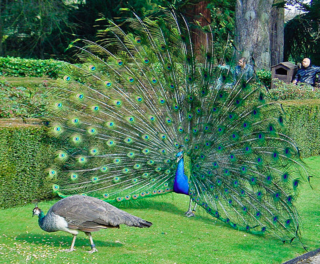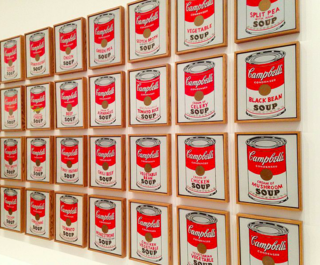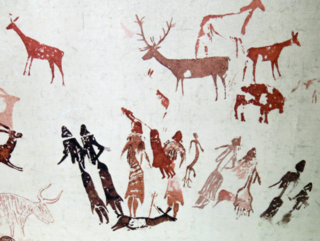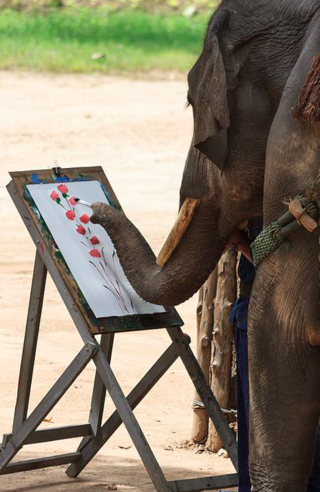A Shape That Is Obvious but Cant Be Touched Art

Source: noonexy/Pixabay
I area of the homo feel that seems not to have parallels out in nature is the arts. It is difficult to conceive of a dove Picasso or a baboon Botticelli. Indeed, merely a few animal species have even the faintest hints of the beginning of civilization. Without civilisation, there really can't exist fine art, as we know it, because art cannot exist separate from culture. Art reflects civilisation, transmits culture, shapes culture, and comments on civilization. At that place is just no mode that animals can possibly feel art every bit we practice.
And in that location is the rub. Of form, they don't experience art as we practice because they don't experience anything equally nosotros do. And we don't experience annihilation as another animal does either. But if we really think near what fine art is and how it showtime began in humans, we might indeed see budding artists among our animal friends.
Art is nearly beauty
If we divorce fine art from its cultural implications, we can hold that art is very oft all to practice with the expression of beauty. Throughout history, much artwork was made for no other explicit purpose than the production of beauty. Artwork is to be beheld and admired. Information technology is breathtaking and tin can even make the states emotional. Information technology is this beauty that I depict the first connection betwixt nature and fine art. Nature and art are both beautiful, no matter how yous define beauty. They both can dazzle us and concord us breathless. They can inspire us and make united states experience connected to something. They both can strike an emotional nerve that leaves an impact on us that is not soon forgotten. Perhaps this connection between fine art and emotion reveals something about the origin of art.
Get-go, allow's consider a specific subset of the beauty we discover in the natural world: beautiful animals. From the unmatched colors of a tropical macaw to the flowing mane of an African panthera leo, to the hit features of a mandarinfish, animals are beautiful. Simply never was the saying, "beauty is in the heart of the holder" more true than in the creature world. The vivid and flashy colors that we come across in many animals have evolved to be conspicuous, to aid the animal "stick out." The most spectacularly beautiful animals are so decorated in order to get the attraction, respect, or fear of other animals. In all cases, the utility of the beauty is found in the reaction it gets from the observer. Can't the exact same thing be said of human art?

Source: ToastyKen/WikiCommons
Although it'southward not all nigh sex, much of beast dazzler is indeed about impressing potential mates. To date, scientists have found no other reason that peacocks take those cute and intricate tails except that peahens seem to dig them. These tails are not a small decorative adornment, either. The peacock tail is more than threescore% of its body length. When they effort to walk, permit lone wing, with those obnoxious monstrosities, it is a deplorable sight indeed.
Nevertheless, peahens are deeply attracted to this tail, and peafowl are not the only species with a strategy like this. Beginning in the simplest of invertebrates, colorful and striking ornamentation has been used to attract mates. I could give a long list of beautifully colored animals whose intricate visual patterns are designed for no other purpose than attraction of a mate, simply I don't recollect it's necessary.
Art and beauty evoke an emotional response
This beauty-as-sexy phenomenon has a deep biological parallel with homo art because it is the connectedness of a visual stimulus with an inner emotional state. In the example of an bonny animal, the external physical beauty is transformed into a want, a behavioral impulse in the brain of the observer. When peahens behold a beautiful peacock, they are "moved" by information technology, in the sense that it affects their electric current mental country. We know this because it affects their beliefs and nosotros presume that behaviors spring from mental states. This is exactly what the fine arts are all near in humans: they employ a visual stimulus to impact the mental or emotional country of the viewers.

Source: Maurizio Pesce/WikiCommons
Art induces call up of past events or emotions
Admittedly, art and beauty in humans is more than than just sex appeal. The effectiveness of fine art depends on some bones assumptions about the knowledge and feel that is common betwixt the artist and the audition. Andy Warhol'due south Campbell's Soup Cans volition probably have very little impact on the bushmen of eastern Africa. Fine art capitalizes on specific stored memories and associations in the encephalon of the observer. Here, nosotros have the second clue to the origin of art in humans: visual recall of past events and emotions.
Equally human brains became more than sophisticated over the final million years, nosotros became capable of storing extensive details as memories, a skill that came in handy as our behaviors became more than detailed. The hunting and gathering mode of life mutual to all of the various hominid species required extensive visual memory. How else could they have accomplished organized group hunting, fashioning of unproblematic tools, and the deciphering of the migratory patterns of big game on the African savannah? These complicated skills require the comparison of current visual cues with past feel in a computational and predictive way. Pattern recognition is what we are talking about here.

Source: Enric/WikiCommons
Farther still, the ability to make and utilise tools, a skill that began in apes and exploded in hominids, requires a great deal of visual and tactile memory. Equally fully mod Homo sapiens began making tools that were more than and more than sophisticated, we suddenly found ourselves with the ability to depict our memories using primitive painting implements. With our newfound cognitive abilities, our impressive memory-recall, and somewhen tools, information technology is not at all surprising that the first art produced by our ancestors depicted the very subject that probably spawned all of our cognitive abilities in the first place: the hunt.
Cave paintings are the earliest artifacts that anthropologists and art historians agree are truly fine art, merely I detect it hard to believe that they didn't also facilitate functions in the communities in which they were created. Nosotros could speculate all day virtually what those functions could accept been, only I think the signal is that the benefits of being able to create a visual representation was immediately recognized. I also seriously doubt that the cave paintings were the first such attempts at visual representations. They were but the first that ended up surviving through the eons.
Fine art aids in communication and education

Source: dave parker/Flickr
As linguistic communication was developing in Homo sapiens during the great leap forward, humans began teaching each other about the tools they'd made, the food they found, and the skills they had perfected. This was the beginning of the concept of instruction. I tin can't imagine that the education of the paleolothic era didn't also make use of visual aids, like teaching does today. Whether they were only rough drawings made by dragging sticks in the dirt, or more than elaborate representation on stone "canvases," I am certain that drawings accompanied speech communication (or gestures) right from the start. In one case once again, the key feature was the ability to use visual representations to induce memory recall or visual understanding. By drawing something, an early homo could make another human remember something.
Diverse forms of drawing, painting, and other visual depictions nearly certainly facilitated communication and education amid early on humans. That much seems rather obvious. In addition, it seems likely that early humans also used the new innovation of artistic depictions for diverse efforts of problem-solving and calculation. As cognition continued to develop, it began to grow into consciousness and introspection as nosotros recall of them today.
The visual arts were probably right there with us forth the way, helping to provide a means to express the circuitous thoughts that were outset to materialize in our massive brains. Indeed, appreciation and understanding of art seem to be amidst the highest-social club functions of the man brain.
For these reasons, I tend to believe that artistic expression and reactions to art evolved mitt-in-mitt with higher cognitive functions in early humans. It is natural that the new richness of our inner experience would also manifest in creative outward expression. In turn, the communication of that inner experience through art would find receptive observers and the phenomenon of art then became ingrained culturally.
I besides fully expect that creative talent would accept eventually been transferred from our culture to our genes. After all, during a million or two years of natural selection, creative power was probable to confer some advantage on those that had it. This reward could take come in the form of increased social standing every bit a leader in the hunt, a prolific teacher of skills, and so on. Any special place in the social structure means greater odds of reproductive success. In this mode, I suspect, humanity evolved into a species of artists and art enthusiasts.
Do other animals make art?
Once humanity developed a trend to produce artistic renderings, there was plenty of biological space for information technology to flourish and reasons why information technology would be favored, merely how might it have emerged in the first place? Surely the beliefs of art product cannot be traced to a singular mutation. What precursors might have existed that allowed art to sally? Are at that place whatsoever examples of animals making something we would consider artful?
At that place is an Indian artist named Siri, whose drawings currently go for hundreds or thousands of dollars. She has been written nigh extensively and featured in publications from Harper'southward Weekly to the Los Angeles Times. Her piece of work ranges from abstract to highly representational fine art including landscapes and self-portraits. Of course, she trained for many years to develop this skill, just she tin can at present complete a painting in mere minutes. Siri is a fifty twelvemonth former Asian Elephant.

Source: liquidkingdom/Flickr
Siri is non alone. Scores of elephants have been taught to pigment. The art that these elephants produce by holding a brush in their trunks is truly impressive. It's certainly amend than anything I could produce. What these elephants are really doing, in terms of producing fine art or but repeating a trained chore, is the subject of heated debate. I don't intend to wade into those murky waters. Rather, I mention painting elephants hither only to indicate that the technical skill set necessary to produce fine art is certainly not unique to humans. These trained painting elephants can take a visual stimulus, even one that is new to them, and recreate it through artistic techniques that they accept learned. They appreciate color, perspective, and proportion, at to the lowest degree in the basic sense. I'm not saying that these elephants are Cézanne, but they're better than Nathan H. Lents, that's for certain.
In species closer to the states, orangutans, chimpanzees, and gorillas take all been taught to draw and paint. Like the elephants, some of them are quite skillful at it. Dissimilar the elephants, at that place is little debate that these primates seem to actually enjoy making the art and will do it spontaneously, without advantage, and for its ain sake. They sometimes brand art that they become quite attached to and never actively show to anyone else.
Once again, I don't want to get into a discussion of what this fine art cosmos actually says near chimpanzee consciousness, although that is interesting to me. My point here is simply that these neat apes all accept the physical power to create visual representations, they enjoy doing and then, and the art that they produce seems to mean something to them. All of those abilities and features were obviously present in early humans and their ancestors every bit well.
Then information technology was not really that big of a jump when early humans looked upward at the cavern wall, dimly lit by a dying fire... and saw a canvas.
Source: https://www.psychologytoday.com/us/blog/beastly-behavior/201709/why-do-humans-make-art
0 Response to "A Shape That Is Obvious but Cant Be Touched Art"
Postar um comentário